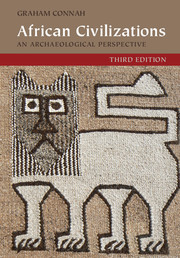Book contents
- Frontmatter
- Dedication
- Contents
- List of figures
- Preface and acknowledgements
- 1 The context
- 2 Origins: social change on the lower Nile
- 3 The Mediterranean frontier: North Africa
- 4 Sudanic genesis: Nubia
- 5 Isolation: the Ethiopian and Eritrean Highlands
- 6 Opportunity and constraint: the West African savanna
- 7 Achieving power: the West African forest and its fringes
- 8 Indian Ocean networks: the East African coast and islands
- 9 Cattle, ivory, and gold: social complexity in Zambezia
- 10 Central Africa: the Upemba Depression, Interlacustrine Region, and Far West
- 11 Settlement growth and emerging polities: South Africa
- 12 What are the common denominators?
- References
- Index
3 - The Mediterranean frontier: North Africa
Published online by Cambridge University Press: 05 November 2015
- Frontmatter
- Dedication
- Contents
- List of figures
- Preface and acknowledgements
- 1 The context
- 2 Origins: social change on the lower Nile
- 3 The Mediterranean frontier: North Africa
- 4 Sudanic genesis: Nubia
- 5 Isolation: the Ethiopian and Eritrean Highlands
- 6 Opportunity and constraint: the West African savanna
- 7 Achieving power: the West African forest and its fringes
- 8 Indian Ocean networks: the East African coast and islands
- 9 Cattle, ivory, and gold: social complexity in Zambezia
- 10 Central Africa: the Upemba Depression, Interlacustrine Region, and Far West
- 11 Settlement growth and emerging polities: South Africa
- 12 What are the common denominators?
- References
- Index
Summary
North Africa is situated between the Sahara Desert and the Mediterranean Sea, between an inhospitable environment discouraging travel and one facilitating extensive maritime contacts. Consequently, it has long tended to look to the north rather than to the south, constituting a frontier zone for the rest of the African continent. Excluding the lower Nile Valley, North Africa's habitable coast to the east is so narrow that in places the desert reaches the sea, but the coast broadens in the west into cultivable plains and still further west there are mountains separating it from the desert. Climatically, North Africa belongs with the Mediterranean, with hot dry summers and mild winters when most of the modest rainfall occurs. Culturally, the region has been a meeting place for people from the Levant, Greece, Rome, Europe, and Arabia and the indigenous Libyans. As a result, North Africa has played a role in the history of Europe as well as in that of Africa. The Mediterranean has been the link, providing relatively easy movement for traders and migrants and a frequent focus for armed conflict. Commencing early in the first millennium BC, a series of colonial and indigenous settlements developed that included urban communities and indications of state development. These were technologically sophisticated societies, at least partly literate, that constituted early examples of African social complexity, not as early as its development in the Nile Valley but still preceding that of most of the rest of Africa. As such, North Africa was eventually to stimulate changes in other parts of the continent, particularly in the Sahel beyond the Sahara and in adjacent regions.
Geographical location and environmental factors
North Africa extends from the lower Nile Valley to the Atlantic coast of Morocco. In terms of modern political geography, it includes western Egypt, Libya, Tunisia, Algeria, and Morocco. In Egypt and Libya the settled zone is mainly restricted to the coast by the Sahara, but in Tunisia, Algeria, and Morocco a variety of different environments, including those of the Atlas Mountains that rise to more than 4,000 metres, have provided greater opportunities for human settlement. Extending almost 3,700 kilometres from east to west, the geographical and environmental diversity of the region is striking.
- Type
- Chapter
- Information
- African CivilizationsAn Archaeological Perspective, pp. 43 - 68Publisher: Cambridge University PressPrint publication year: 2015



